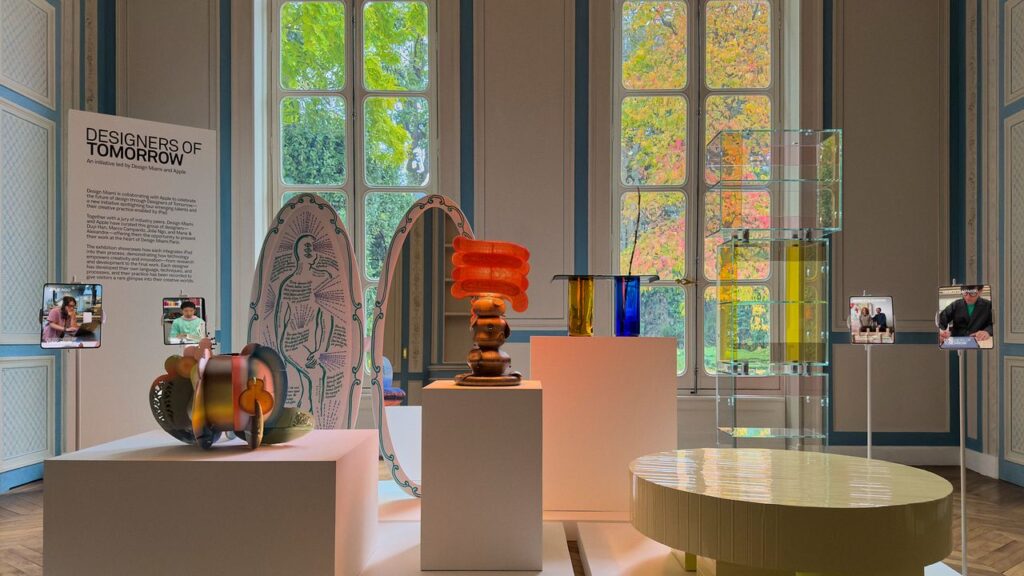Spiritually, Paris is a far cry from Silicon Valley. So you’d be forgiven if it’s not the first destination that comes to mind regarding technological artistic advances. Accordingly, L’Hôtel de Maisons, an 18th-century manse and former residence of Karl Lagerfeld, may seem like an unlikely place for Cupertino, California-based Apple to launch an exhibit spotlighting emerging designers. But at the third edition of Design Miami/Paris, it’s clear that technology is becoming an important—if not essential—tool for artists who are pushing the boundaries of creativity.
As for the location? “Paris has a long history of design,” says AD100 designer Rodman Primack, who curated Designers of Tomorrow, a showcase by Apple and Design Miami that will take place in the Beaux-Arts gem from October 21 through 26. “It was the capital of design for much of the 20th century, and it’s once again emerging as an important capital for collectable design and art alike.”
Along with Primack, Design Miami CEO Jen Roberts and Apple Design Studio’s Molly Anderson and Alan Dye helped decide the exhibition’s lineup: Marco Campardo, Marie et Alexandre, Atelier Duyi Han, and Jolie Ngo. “Outside of creating beautiful objects, the featured designers share a curiosity for experimentation with materials and processes, blurring the line between digital design tools, traditional craftsmanship, and inventive production methods,” Anderson tells AD. “The pieces achieve a distinct balance; feeling technical, modern, yet tactile and timeless.”
To whittle 21 candidates down to the featured four, a set of jurors (which include industry authorities Aric Chen, Faye Toogood, Sabine Marcelis, and Roberts, among others) carefully looked at how technology boosted each of the designers’ processes. “One of our ambitions when we design products is to create tools and experiences that allow others to express their own creativity,” says Apple’s Dye. All submissions were conceived with iPad technology (and the brand fittingly just announced a new iPad Pro). That said, Primack is quick to vouch for the human element behind the exhibit. “It’s not a love letter to the machine,” he explains. “Technology is a tool to help them create what they envision.” Here’s how each of the designers balanced craft and tech in their works.
Marco Campardo
For UK-based Marco Campardo, process is paramount in his material experimentation, and the result is the latest addition to his Jello series, a soft yellow coffee table. Don’t let the name fool you: The final form, made from resin, intentionally resembles—since we are in France—beurre. “It was inspired by the simple act of unwrapping a piece of butter,” the designer tells AD. “I noticed the textures left behind on its surface by the packaging, and that moment sparked my curiosity about molds.” While the table appears baguette-ready, Primack likes to think of it “as though Jolly Rancher came out with a furniture line.”
Marie et Alexandre
Paris-based design duo Marie et Alexandre cut their teeth at the acclaimed Studio Bouroullec; here, their distinctively warm design language is articulated through an exploration of post-Memphis color, swapping the movement’s primary shades for softer tones in their “CR Boxes System.” Also in the exhibit: “Vase Double, 2025” a set of two thermoformed glasses. “We wanted to explore two approaches using the same base material—industrial glass sheets,” the duo note, adding that the totem involves cold assembly with colored film, and the vase was shaped in a kiln. Aside from its method of being made, the totem has a secret: The boxes are modular, and can transform into shelves or small desks.
Atelier Duyi Han
“I’ve been wanting to do a mirror because it’s a device for looking at oneself,” says Shanghai-based Duyi Han. He further philosophizes that his dual surface looking glass, named “Noetigram v0.9,” involves not just the physical self, but also the psychological self. The satin embroidered design, inspired by anatomical diagrams and acupuncture maps, also features psychology-based phrases that Han sourced from AI. “It’s immediately new-fashioned and arrives at a very new place,” notes Primack of the work.
Jolie Ngo
Santa Barbara-based Jolie Ngo’s lantern vessel and table lamp—both programmed using MacBook Pro—represent a distinct union of craft and technology. In “Lantern Vessel in Between Worlds,” the harmonic grooves are inspired by Vietnamese lanterns and painterly strokes. (It’s also made from 3D clay printing.) “They invite a slower kind of looking,” says Ngo. “Table Lamp in Cherry Blossoms and Himalayan Salt,” on the other hand, sports a ceramic base that supports a 3D-printed shade in a pink blossom hue. “Integrating digital tools has completely changed my sense of what is possible, especially in clay,” Ngo says. “It has opened up a new vocabulary of form, helping me create gestures and layers I couldn’t capture by hand. I think of the digital process as another form of touch. It doesn’t replace the hand, but it extends it.”










